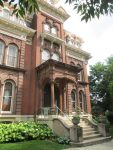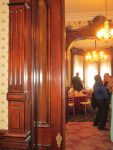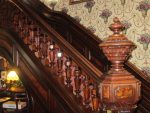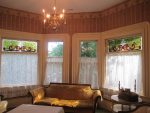In July 2016, Renner Larson and Audrey Schlofner got married at the Jacob Henry Mansion in Joliet. I wrote up this long-ish version of the place where the event happened, for those who want more than the short insert in the program!

So, who was Jacob Henry?
Jacob Apgar Henry (1825-1908) made his substantial wealth in railroads and the industries that served them, like quarries. He moved to Joliet, Illinois, in 1846, having started his career on the East Coast with the Hartford & New Haven Railroad in 1842. He secured construction contracts to expand railroads in Illinois, Indiana and Ohio. As his success increased, he expanded into real estate, electric street cars, insurance, and banking, becoming a principal stockholder in Will County (IL) National Bank. He was a Universalist (before they merged with the Unitarians and became UUs.)
What about the house he built?
The nearly 17,000-square-foot mansion was built between 1873 and 1876 in a hodge-podge of styles known as “eclecticism.” It is listed on the National Register of Historic Places, and is part of Joliet’s East Side National Register District. Before Henry built this house he lived next door in the modest frame house at 22 Eastern Avenue. After his mansion was finished, his daughter, Helen Henry, and son-in-law, Julius Folk, lived in that house.
The mansion is three stories tall with a central tower. Henry owned a limestone quarry nearby, so it is no surprise that the basement, foundation, and front and side porches are of limestone. Joliet boosters seem to love this detail: “The largest stone ever quarried lies in the sidewalk under the front entry gate. The stone is 9’x22’x 20” thick,” but I don’t think that is nearly as interesting as the fact that prisoners from the Joliet penitentiary dug out the rock. You can see a photo of the quarry and the prison here. According to the National Register, “The walls of the structure are constructed of red Illinois sandstone and deep red brick specially fired in Ohio (wrapped individually and shipped by barge to Joliet).” The roof shingles are slate. In 1885, on the occasion of his second marriage (his first wife died in 1878), Henry added what was called “an oriental bay” with a copper dome on the south façade.
Speaking of the roof, the way that it encloses the top floor is called a Mansard roof, deriving from the 17th-century French architect, Francois Mansart, who popularized it; then in the 19th century in France it became popular again. It’s one reason why the mansion is sometimes labeled Second Empire (because the French president Louis-Napoleon declared himself emperor Napoleon III in 1852 and this style came back into fashion.) So a little bit of France and quite a few Renaissance details revived in the middle of the U.S.!

Inside there are carved and inlaid pocket doors (they slide into the walls.)
Much of the woodwork is done in walnut, including the staircase.

There’s a marvelous bay window on the north side.

There’s a church on this property. What about that?
The Central Presbyterian Church (“Old Central”) sits on land donated by Jacob Henry to the church; he provided the stone as well. The church is on the National Register as well. It was designed by the firm of Wilm Knox and John Elliot in 1895. Knox and Elliot were active in Cleveland, Toronto, and Chicago from 1888 until their deaths in the early 20th century. These two architects met when they worked for Daniel Burnham, who ran a huge architectural and planning firm in Chicago; Burnham is famous for his 1909 Plan of Chicago. Surprise! “Old Central” is built of Joliet limestone. Its style is also eclectic, with Gothic Revival features, like the wooden tracery on the gable of the porch. The use of several colors of stone is called polychromy. While the church was in use as a church (until about 1995), it was the site of many events, including the wedding of Marshall Field IV to Kay Woodruff of Joliet in the 1950s.

Joliet, Illinois, was a transportation hub
White settlers moved in to the Joliet area about 1831, and the town, originally called Juliet, was incorporated in 1852, re-named in honor of the 17th-century French-Canadian Louis Joliet. In 1871, about the time that Jacob Henry was planning his mansion, Joliet had about 10,000 residents. On the Des Plaines River and with the Illinois & Michigan Canal passing through after its completion in 1848, there were good locations for businesses and houses. In the neighborhood of the Henry Mansion, you can still see limestone curbs and tiles with the street names embedded in the sidewalks. Other rich folk lived in this area, once dubbed “Silk Stocking Row.”

